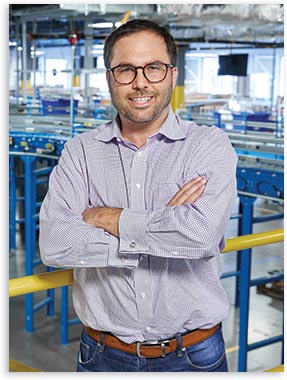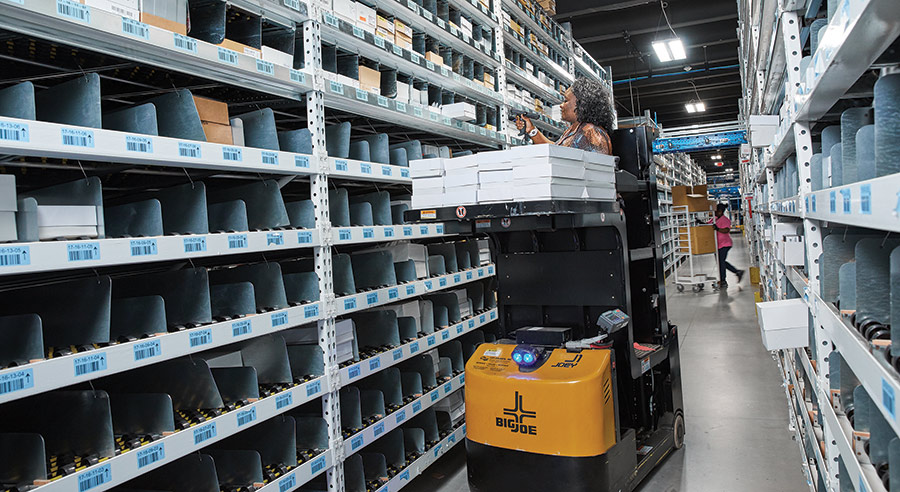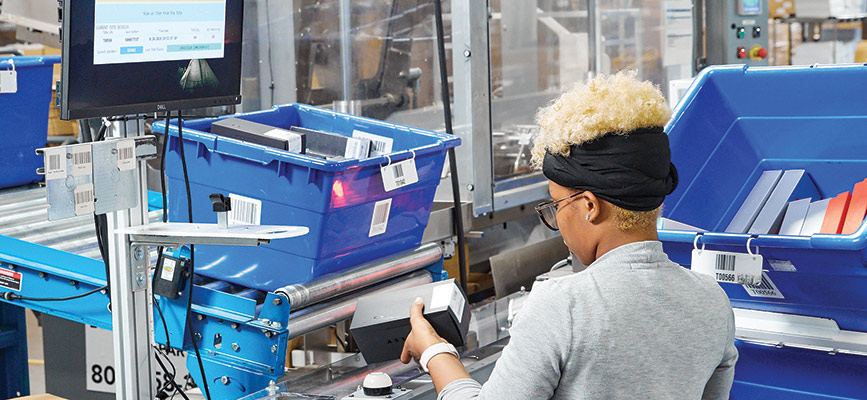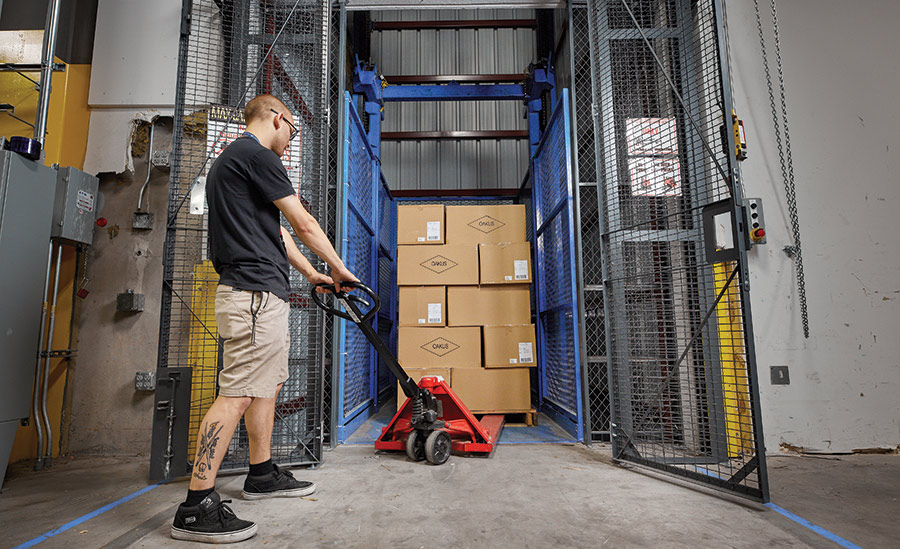System Report: Luxottica keeps it simple
Simplification and consolidation drove the design of a new 1.1-million-square-foot logistics campus in Georgia, including a 713,000-square-foot distribution center.

When Luxottica Group S.p.A. decided to build a new 713,000-square-foot distribution center in McDonough, Ga., the Italian manufacturer and retailer of eyewear, accessories and fashion had three primary goals, according to Massimo Sapone, the senior vice president of logistics and planning for North America.
The first was to consolidate locations in Georgia, Ohio and California into one North American hub that handled all of Luxottica’s brands and provided one face to the customer. But, it wasn’t just a consolidation of Luxottica’s order fulfillment operations.
Take an inside look into Luxottica’s new fulfillment center
In addition to the distribution hub, the McDonough campus features four buildings totaling 1.1 million square feet, including a 50,000-square-foot aftersales distribution center for processing returns and a center for sourcing and planning. In all, 2,000 employees support the logistics and ophthalmic manufacturing operations.
The second was to improve speed to market. “The idea is that we want to be simpler and faster, and we can do that through consolidation of our facilities and the simplification of our processes,” Sapone says.
Third, they put in one place manufacturing and distribution processes, a move that would position Luxottica as the industry leader in customer service. “Our ambition is to gain the No. 1 operation in our industry, and I believe we are already pulling away from our competitors,” Sapone notes.
It is a unique facility, essentially three 238,000-square-foot facilities with 12-foot ceilings stacked on top of one another. The three levels—unusual in North America but more common in Europe—connect with a high-speed elevator and conveyor for lighter weight loads and two heavy-duty freight elevators for heavier pallet loads. Putaway, replenishment and picking operations are directed by a warehouse management system (WMS), RF scanning and lights, depending on the process. The facility also features an extensive conveyor and sortation system, a put wall area and automated packaging for small and medium-sized orders. As part of this project, Luxottica also implemented SAP in McDonough—its global enterprise resource planning (ERP) platform.
At the moment, the ground floor handles receiving and shipping along with order fulfillment processes for a common pool of frames for Luxottica’s wholesale and e-commerce eyewear businesses. The second floor is the manufacturing lab, where prescription lenses are created and married with frames that are stored there to support the lens business. The third floor is reserved for Oakley branded apparel, footwear and accessories—Luxottica and Oakley eyewear are on the first floor.
 A facility with 12-foot ceilings might seem unusual in an era when most DCs are more than 30 feet tall or higher. But Vince Pusateri, the senior director of engineering and network strategy for North America, notes that given the size of the products handled in the eyewear business, the ability to efficiently store and pick about 55,000 SKUs in the facility is more important than ceiling height.
A facility with 12-foot ceilings might seem unusual in an era when most DCs are more than 30 feet tall or higher. But Vince Pusateri, the senior director of engineering and network strategy for North America, notes that given the size of the products handled in the eyewear business, the ability to efficiently store and pick about 55,000 SKUs in the facility is more important than ceiling height.
“This was a giant project that we launched in 2016, building the campus from scratch,” adds Sapone. “But we now have a distribution facility that enables our business model and allows us to service almost 6,000 stores from one location.”
Made in Luxottica
Luxottica is a leader in the design, manufacture and distribution of fashion, luxury and sports eyewear. According to the company, its portfolio includes proprietary brands such as Ray-Ban, Oakley, Vogue Eyewear, Persol, Oliver Peoples and Alain Mikli. It also licenses brands, including Giorgio Armani, Burberry, Bulgari, Chanel, Coach, Dolce&Gabbana, Ferrari, Michael Kors, Prada, Ralph Lauren, Tiffany & Co., Valentino and Versace.
The group’s global wholesale distribution network covers more than 150 countries and is complemented by a global retail network of approximately 9,000 stores, with LensCrafters and Pearle Vision in North America; OPSM and LensCrafters in Asia-Pacific; GMO and Óticas Carol in Latin America; Salmoiraghi & Viganò in Italy; and Sunglass Hut worldwide. In 2017, with approximately 85,000 employees, Luxottica posted net sales of more than $10.4 billion.

An associate scans a putaway location as part of the receiving process. Given the size of the products, most storage is on shelving.
Luxottica touts its vertically integrated business model, built over decades, as one of its competitive advantages. Leonardo Del Vecchio, the group’s founder, chose to produce entire frames rather than just components. It’s manufacturing capabilities were complemented by the expansion of its wholesale and retail distribution network and the high value-added business of lens finishing, like the operation on the second floor of the McDonough facility. Dubbed “Made in Luxottica,” owning the supply chain from design through distribution “gives the company a unique understanding of consumer trends and tastes, welcomes synergies and encourages cross-functional innovation,” the company states.
In some respects, the vertically integrated model paved the way for the McDonough campus. The rationalization of the network began around 2016. Before that, Luxottica operated a distribution center in California for the Oakley brand; another large facility near Cincinnati, Ohio, for the rest of its portfolio; and a smaller facility in McDonough to support a retail and wholesale operation. “Globally, we said we wanted a logistics hub in each of our four global distribution and manufacturing points,” says Pusateri. “For North America, we chose McDonough as the best location to support future growth, and that’s what fueled the development of the campus.”
Luxottica broke ground in McDonough in 2016 and began building the DC in 2017. “Overall, it was a gigantic job, as you can imagine,” says Sapone. “We went from 250,000 square feet to 1.1 million square feet and from 400 to nearly 2,000 employees.”
Consolidation and simplicity
When it comes to order fulfillment, the new facility was designed for the consolidation and simplicity Sapone mentioned earlier. For instance, both distribution and manufacturing were combined in the facility, which not only handles sunglasses, but the prescription eyewear side of Luxottica’s business in the manufacturing lab on the second floor. “We now have the opportunity to manufacture lenses for prescription glasses in the same building that serves our marketplace,” notes Pusateri. “Our systems were designed to move product between the second and third floors to consolidate our shipments on the first floor.”

Large orders are batch picked to cart and then consolidated into totes.
It was also designed to manage a high number of SKUs that turnover quickly, which means the focus is on active pick locations, and to efficiently pick items, partial cases and some full cases rather than pallets. “The majority of our picks are unit picks and the majority of our orders are less than two items,” says Sapone. What’s more, he adds that while Luxottica manages between 30,000 and 35,000 SKUs in optical and another 20,000 SKUs in apparel and footwear, as a fashion-forward business, a new collection of 5,000 SKUs is injected into the supply chain every quarter. Thus, inventory rotates often.
To design its picking processes, the order fulfillment team looked at the segmentation of orders. That led to multiple batch-picking solutions, depending on the size of the order. There is one batch-picking solution for single unit wholesale and e-commerce orders and rush orders; and a batch picking solution for multi-line orders. These types of orders are sorted to packing stations designated by order type, including an automated packaging line for single orders.
Medium orders, defined as two to 40 items, are batch-picked and sorted to one of seven light-directed put walls for consolidation. Large orders, defined as more than 40 pieces, are picked complete to the shipping container and sent to a pack station where the order is verified, sealed and labeled. And, separate flows are in place for export orders and value-added services, such as custom packaging for higher-end items, which is an increasing part of the business.

Product is delivered to the second and third floors by a freight elevator.
As a rule, items are picked to either totes or shipping cartons on carts. Tasks are sent to the order selectors’ scanners and once all the totes or containers on a cart are picked complete, they are inducted onto the conveyor system. On the third floor, they are picked to a pallet, which is delivered to the first floor by elevator and then inducted onto the conveyor system. From there, they are sorted to a packing station for the order type.
Working in phases
In putting the distribution center together, Luxottica took a phased approach to automation, something it calls the “Road to the Future.”
Phase one was going live with light automation. “We had to relocate and consolidate this business from two other distributions, and we did not want to have a lot of complexity,” recalls Pusateri. “So, to start, we set up a shipping sorter where we could induct packed orders and convey them right to trailers that are a direct load.” Orders were picked to cart using RF scanning guns, the cart was rolled to a pack station and from the pack station it was conveyed to a shipping sorter.
Phase two, which was started in January 2017 and completed last October, saw the implementation of a conveyor system that runs down the middle of the warehouse. Multiple induction points serve the various pick zones and sortation to the various packing stations. Now, instead of rolling a cart to a pack station, an order selector can take it to the nearest induction point, speeding up the process.
Luxottica is in the planning stages for phase three. One project is to consolidate the “resale business,” or processing of returns, into the distribution center. Currently, returns are inspected and processed at another facility on the campus and then delivered to the DC to be put back into inventory. Another is to automate inbound receiving and replenishment, including tying inbound directly to the second floor by conveyor. Finally, they’re looking to further segment large orders into one category of 40 to 100 pieces and another category of extra large orders of from 100 up to 500 pieces. “We have an opportunity to move from pick-to-carton to batch picking utilizing consolidation points similar to the put wall system,” Pusateri says. Phase three is expected to be complete in early 2019.
With a little more than two years of operations under its belt, Sapone says Luxottica has a distribution hub that enables its go-to-business strategy and is simpler and faster than how it operated in the past. “We’re now focusing on continuous improvement,” he says, “certifying our staff on lean and moving toward Six Sigma. And, we continue to look at how we can standardize and simplify steps so we can be the best logistics organization possible.”

Article Topics
Latest in Logistics
S&P Global Market Intelligence’s Rogers assesses 2024 import landscape Pitt Ohio exec warns Congress to go slow on truck electrification mandates Q1 intermodal volumes are up for second straight quarter, reports IANA Supply Chain Management Software: Build the foundation, deliver the value 2024 State of Freight Forwarders: What’s next is happening now Ryder opens up El Paso-based multi-client facility logistics facility Autonomous mobile robots (AMRs) on a mission to automate More LogisticsAbout the Author
Subscribe to Logistics Management Magazine

Find out what the world's most innovative companies are doing to improve productivity in their plants and distribution centers.
Start your FREE subscription today.
May 2024 Logistics Management

Latest Resources














